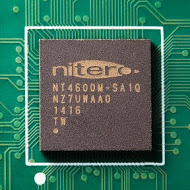Slashed NICTA lab's research still benefits high-speed Wi-Fi

Close to a decade of research into radio frequency technology at the Victorian research lab of National ICT Australia has helped its spin-off company Nitero develop low-power 60GHz Wi-Fi technology that will offer wireless speeds at up to 4.6Gbps.

Nitero is a semi-conductor technology company that was spun off from NICTA in 2011, and is now headquartered in Austin, Texas, with a design centre in Melbourne.
The company's flagship technology is what was called Gi-Fi, but is now referred to as 60G. The Wi-Fi technology could one day replace HDMI cables, and once rolled into smartphones, could be used to stream high-definition video, desktop screens, and video games, with low latency.
Nitero this week announced its first product in the 60Hz family, the NT4600, and the company's CEO Pat Kelly told ZDNet that it was 10 times more power efficient, because the company focused on making the chip for mobiles, rather than PCs.
Due to the high frequency, the 60GHz Wi-Fi, compliant with the 802.11ad standard, is short range, usually around 10 meters, and cannot easily get through walls or around corners. For this reason it is complementary to 802.11ac, and is more suited to single rooms, rather than an entire household or office.
"For any short-range devices, we really expect this will become the go-to technology in the future. You can have everyone in an apartment complex, or everyone come back to a hotel at night and there will be plenty of bandwidth for everybody," he said.
"It's not your regular Wi-Fi that goes throughout the house, it has got to stay in a room. With 60GHz, you'll be able to download a movie or a TV series in what we call a credit-card transaction time."
The power for 4K streaming is 150mW, with peak power at 450mW. It is able to get USB3-type speeds, and is 60mm2 in size.
Much of what Kelly calls the "black magic" of what developed the chipset comes from the RF research conducted by NICTA over the last decade prior to Nitero being spun out.
"We've got 10 years of total work and 60GHz behind us, whereas some of our competitors started in 2008 or 2009," he said
"We had the benefit of all this great work done at the NICTA lab. Australia's making this big impact on Wi-Fi."
The Victorian research lab for NICTA was the biggest victim of the Victorian Government budget cut in February, which led to the axing of around 30 positions in the research lab.
Kelly said the decision to cut jobs from the lab was regrettable.
"It does seem like governments — they've got to take care of the budgets, and sometimes there are hard decisions that have to be made — but personally, the shame of it was just how significantly I saw the Victoria research lab get cut," he said.
"This technology came out of that group, and my understanding is they were cut pretty significantly."
As the Victorian government pulled funding from the research organisation, so too the Federal government announced in its Budget in May that it would reverse a funding decision by the former Labor government, and would not extend funding to NICTA past 2016.
"It was always expected that funding from the private sector would play an increasingly important role in supporting NICTA's operations," Turnbull said at the time.
"NICTA's rapid growth in commercial revenue, through its partnerships with domestic and overseas firms, shows it can draw funding from a wider range of sources."
The organisation has made inroads into finding alternate sources of funding, announcing in May that it had signed a multi-million dollar deal with telco giant Telstra to fund research into security, privacy, network planning, media, and cloud projects.